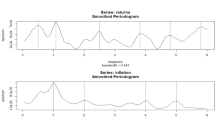Abstract
A popular model to describe an economic time series is that of an autoregression, in which the current value is expressed as a function of past values. This is a simple class of time series model and methods of determining the order of an autoregression are considered. Moving average and mixed models may also be fitted, and methods for building such models are developed by way of several empirical examples. An important requirement for time series modelling is that of stationarity, and the use of differencing and of formal testing procedures for inducing such a property are both considered. It is also important to distinguish between various types of non-stationarity, and the trend stationarity versus difference stationarity distinction is developed in some detail.
Access this chapter
Tax calculation will be finalised at checkout
Purchases are for personal use only
Preview
Unable to display preview. Download preview PDF.
Similar content being viewed by others
Notes
Autoregressions were first introduced by the famous British statistician George Udny Yule during the 1920s: see G.U. Yule, ‘On a method of investigating periodicities in disturbed series, with special reference to Wolfer’s sunspot numbers’, Philosophical Transactions of the Royal Society of London, Series A 226 (1927), 267–298.
For details on the historical development of these models, see Terence C. Mills, The Foundations of Modern Time Series Analysis (Palgrave Macmillan, 2011) and A Very British Affair: Six Britons and the Development of Time Series Analysis (Palgrave Macmillan, 2013).
Acronyms abound in time series analysis and have even prompted a journal article on them: Clive WJ. Granger, ‘Acronyms in time series analysis (ATSA)’, Journal of Time Series Analysis 3 (1982), 103–107, although in the three decades since its publication many more have been suggested.
These extensions have been covered in, for example, Terence C. Mills and Raphael N. Markellos, The Econometric Modelling of Financial Time Series, 3rd edition (Cambridge University Press, 2008).
Author information
Authors and Affiliations
Copyright information
© 2014 Terence C. Mills
About this chapter
Cite this chapter
Mills, T.C. (2014). Basic Time Series Models. In: Analysing Economic Data. Palgrave Texts in Econometrics. Palgrave Macmillan, London. https://doi.org/10.1057/9781137401908_18
Download citation
DOI: https://doi.org/10.1057/9781137401908_18
Publisher Name: Palgrave Macmillan, London
Print ISBN: 978-1-349-48656-4
Online ISBN: 978-1-137-40190-8
eBook Packages: Palgrave Economics & Finance CollectionEconomics and Finance (R0)



